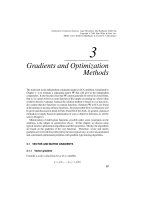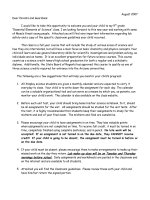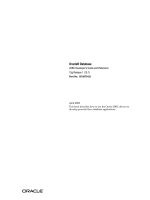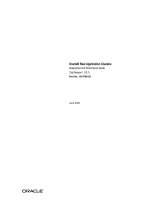Tài liệu Oracle Performance Tuning and Optimization pptx
Bạn đang xem bản rút gọn của tài liệu. Xem và tải ngay bản đầy đủ của tài liệu tại đây (6.14 MB, 710 trang )
i
Oracle
Performance Tuning
and Optimization
Oracle
Performance Tuning
and Optimization
Edward Whalen
201 West 103rd Street
Indianapolis, Indiana 46290
®
ii
Oracle Performance Tuning & Optimization
Publisher and President:
Richard K. Swadley
Acquisitions Manager:
Greg Wiegand
Development Manager:
Dean Miller
Managing Editor:
Cindy Morrow
Marketing Manager:
Gregg Bushyeager
To my father.
Copyright 1996 by Sams Publishing
FIRST EDITION
All rights reserved. No part of this book shall be reproduced, stored in a retrieval
system, or transmitted by any means, electronic, mechanical, photocopying,
recording, or otherwise, without written permission from the publisher. No patent
liability is assumed with respect to the use of the information contained herein.
Although every precaution has been taken in the preparation of this book, the
publisher and author assume no responsibility for errors or omissions. Neither is any
liability assumed for damages resulting from the use of the information contained
herein. For information, address Sams Publishing, 201 W. 103rd St., Indianapolis,
IN 46290.
International Standard Book Number: 0-672-30866-X
Library of Congress Catalog Card Number: 95-72345
99 98 97 96 4 3 2 1
Interpretation of the printing code: the rightmost double-digit number is the year of
the book’s printing; the rightmost single-digit, the number of the book’s printing.
For example, a printing code of 96-1 shows that the first printing of the book
occurred in 1996.
Composed in AGaramond and MCPdigital by Macmillan Computer Publishing
Printed in the United States of America
All terms mentioned in this book that are known to be trademarks or service marks
have been appropriately capitalized. Sams Publishing cannot attest to the accuracy of
this information. Use of a term in this book should not be regarded as affecting the
validity of any trademark or service mark.
Acquisitions Editor
Rosemarie Graham
Development Editors
Byron Pearce
Todd Bumbalough
Software Development
Specialist
Steve Flatt
Production Editor
Alice Martina Smith
Technical Reviewers
David Kennedy
Stephen Tallon
Editorial Coordinator
Bill Whitmer
Technical Edit Coordinator
Lynette Quinn
Formatter
Frank Sinclair
Editorial Assistants
Sharon Cox
Andi Richter
Rhonda Tinch-Mize
Cover Designer
Tim Amrhein
Book Designer
Alyssa Yesh
Copy Writer
Peter Fuller
Production Team Supervisor
Brad Chinn
Production
Mary Ann Abramson
Georgianna Briggs
Jama Carter
Amy Chinn
Michael Dietsch
Jason Hand
Sonja Hart
Ayanna Lacey
Clint Lahnen
Paula Lowell
Brian-Kent Proffitt
Bobbi Satterfield
Susan Van Ness
Colleen Williams
iii
Overview
Introduction xxiv
PART I Introduction 1
1 Introduction to Oracle 3
2 Understanding Terms 21
3 What Is a Well-Tuned System? 31
4 Tuning Methodology 41
5 Benchmarking 51
6 Performance Monitoring Tools 73
7 Performance Engineering Starts at the Design Stage 81
PART II Tuning the Server 89
8 What Affects Oracle Server Performance? 91
9 Oracle Instance Tuning 97
10 Performance Enhancements 139
11 Tuning the Server Operating System 167
12 Operating System-Specific Tuning 177
13 System Processors 205
14 Advanced Disk I/O Concepts 213
15 Disk Arrays 225
PART III Configuring the System 243
16 OLTP System 245
17 Batch Processing System 265
18 Decision Support System 285
19 Data Warehousing System 303
20 BLOB System 323
21 The Oracle Parallel Server System 339
22 Optimal Backup and Recovery 349
23 Miscellaneous Configurations 367
PART IV Tuning SQL 391
24 What Is a Well-Tuned SQL Statement? 393
25 Using EXPLAIN PLAN and SQL Trace 403
26 Tuning SQL Statements 419
27 Using the Oracle Optimizer 437
28 Using Procedures, Functions, and Packages 449
29 Providing for Data Integrity and Triggers 461
30 Using Hints 475
31 Introducing SQL Development Tools 489
32 Miscellaneous SQL Topics 501
iv
Oracle Performance Tuning & Optimization
PART V Tuning the Client 513
33 What Affects Client Performance? 515
34 Tuning the Client System 525
35 Using GUI Builders 533
36 Using Middleware Products 555
PART VI Tuning the Network 563
37 What Affects Network Performance? 565
38 Tuning the Network Components 573
PART VII References 579
A Review of Tuning Guidelines 581
B Quick Reference 595
C Flowcharts 603
D Glossary 607
E Oracle Tuning Parameters 619
F Contents of the CD-ROM 645
Index 649
v
Contents
Introduction xxiv
Part I Introduction 1
1 Introduction to Oracle 3
The Database 4
The Physical Layer 4
The Logical Layer 5
The Oracle Instance 8
The Oracle Memory Structure 8
System Global Area (SGA) 9
Program Global Area (PGA) 10
Processes 10
How Transactions Work 12
Oracle Products 13
Oracle RDBMS Products 13
Oracle Workgroup Server 15
Personal Oracle for Windows 16
Oracle Development Tools 16
Oracle Applications 17
Oracle Services 18
Summary 19
2 Understanding Terms 21
Terms 22
RDBMS Functionality 26
Checkpoint 26
Logging and Archiving 26
Business Models 27
OnLine Transaction Processing (OLTP) 27
Batch Processing 27
Decision Support 28
Data Warehousing 28
Binary Large Objects (BLOBs) 28
Unit Conversions 28
Powers of 10 29
Storage Units 29
Summary 30
3 What Is a Well-Tuned System? 31
Client/Server Computing 32
The Client or Front-End Machines 33
The Server 33
The Network 35
Client/Server Checklist 35
vi
Oracle Performance Tuning & Optimization
Host-Based Computing 36
The Front-End Application 36
The Database 36
Terminal-Based Checklist 37
Batch Computing 38
Batch-Processing Checklist 39
Exceptions 39
Multimedia Systems 39
Shipping Systems 39
Summary 40
4 Tuning Methodology 41
Goals 42
Throughput 42
Response Time 42
Connectivity 43
Fault Tolerance 43
Load Time 44
Tuning Methodology 44
Examine the Problem 45
Determine the Problem 47
Determine the Solution and Set Goals 48
Test the Solution 49
Analyze the Results 50
Summary 50
5 Benchmarking 51
Introduction to Benchmarking 52
Industry Standard Benchmarks 52
The Transaction Processing Performance Council (TPC) 53
TPC Rules and Regulations 55
Results 56
Benchmarks 57
Publication Benchmarks 69
Custom Benchmarks 70
Writing Your Own Benchmark 70
Summary 72
6 Performance Monitoring Tools 73
Oracle Tools 75
SQL*DBA Monitor 76
Server Manager 76
Oracle SNMP Agents 76
SQL Trace 76
EXPLAIN PLAN 77
vii
Contents
OS Tools 77
Third-Party Tools 78
Real-Time Monitors 79
Threshold Monitors 79
Summary 80
7 Performance Engineering Starts at the Design Stage 81
Design Stage 82
Database Layout 82
Indexes and Clusters 83
Application Design 83
Hardware Sizing 83
Network Considerations 84
Performance Tuning after the System Is Built 84
Tuning the Client 85
Tuning the Server 85
Tuning the Network 85
Summary 86
Part II Tuning the Server 89
8 What Affects Oracle Server Performance? 91
System Bottlenecks 92
Finding the Bottleneck 92
Removing the Bottleneck 93
System Tuning 93
Tuning RDBMS Resources 93
Tuning OS Resources 94
Tuning Hardware Resources 94
Other Tuning Factors 95
System Limitations 95
Summary 95
9 Oracle Instance Tuning 97
Tuning Memory 98
Tuning the Operating System 99
Tuning the Private SQL and PL/SQL Areas 100
Tuning the Shared Pool 100
Tuning the Buffer Cache 107
Tuning the I/O Subsystem 108
Understanding Disk Contention 109
Identifying Disk Contention Problems 110
Solving Disk Contention Problems 111
Reducing Unnecessary I/O Overhead 117
Migrated and Chained Rows 117
Dynamic Extensions 118
viii
Oracle Performance Tuning & Optimization
PCTFREE and PCTUSED Command Options 119
A Review of I/O Reduction Techniques 122
Tuning Rollback Segments 123
Understanding How Rollback Segments Work 123
Tuning Rollback Segments 126
Review of Rollback Segment Tuning 130
Checking for Latch Contention 130
Redo Log Buffer Contention 130
Redo Log Buffer Latch Contention 131
Tuning Checkpoints 133
Optimizing Archiving 134
Adjusting the Effect of Archiving 135
Optimizing Sorts 135
Minimizing Free List Contention 136
Summary 137
10 Performance Enhancements 139
Block Size 140
Clusters 141
Direct-Write Sorts 143
Fragmentation 144
Hash Clusters 146
When To Hash 147
Indexes 148
Index Types 149
How the Oracle Index Works 149
What To Index 150
Multiblock Reads 152
Multiblock Writes 152
Parallel Query Option 153
Parallel Query Processing 153
Direct-Write Sorts 158
Parallel Index Creation 159
Parallel Loading 159
Parallel Recovery 160
Parallel Server Option 161
Spin Counts 164
Summary 164
11 Tuning the Server Operating System 167
Goals 168
Processes 169
Memory 170
I/O 170
ix
Contents
Direct or Synchronous I/O 172
Asynchronous I/O 172
Miscellaneous 173
Post-Wait Semaphore 173
Scheduling and Preemption 173
Cache Affinity 174
Summary 174
12 Operating System-Specific Tuning 177
NetWare 178
Architectural Overview 178
Tuning Considerations 179
Windows NT 183
Architectural Overview 183
Tuning Considerations 185
OS/2 188
Architectural Overview 188
Tuning Considerations 188
UNIX 191
Architectural Overview 192
Tuning Considerations 192
Summary 203
13 System Processors 205
Overview of Computer Architecture 206
CPU and Cache 206
CPU Design 207
CISC Processors 207
RISC Processors 208
Multiprocessor Systems 209
SMP Systems 209
MPP Systems 209
CPU Cache 210
System Memory Architecture 210
Virtual Memory System 211
Bus Design 211
Summary 212
14 Advanced Disk I/O Concepts 213
Disk Operation 214
Seek Time 216
Rotational Latency 217
Data Transfer Rate 217
Queue Time 218
x
Oracle Performance Tuning & Optimization
Disk Performance 219
Random I/Os 220
Sequential I/Os 220
Summary 223
15 Disk Arrays 225
How Does a Disk Array Work? 226
Software Array 227
Hardware Array 227
RAID Technology 229
RAID-0 230
RAID-1 230
RAID-2 231
RAID-3 231
RAID-4 232
RAID-5 232
Fault-Tolerance Concerns 233
No Data Protection 233
Full Data Protection 234
Partial Data Protection 234
Configuring RAID for RDBMS Performance 235
Isolate Sequential I/Os 236
Distribute Random I/Os 237
Size the Volume Properly 238
Configure for the Disk Array 240
RAID Comparison 240
Summary 241
Part III Configuring the System 243
16 OLTP System 245
Characteristics of the OLTP System 246
Data Access Patterns 246
System Load 247
Goals 248
Design Considerations 249
Physical Data Layout 250
Hardware Considerations 253
Tuning Considerations 253
Oracle Tuning 254
Server OS Tuning 255
Enhancements 256
Oracle Parallel Server Option 257
Hardware Enhancements 257
xi
Contents
Performance Verification 260
What To Test in the RDBMS 261
What To Test in the OS 261
Benchmarks 262
Summary 262
17 Batch Processing System 265
Characteristics of the Batch Processing System 266
Data Access Patterns 267
System Load 267
Goals 268
Design Considerations 270
Physical Data Layout 270
Hardware Considerations 274
Tuning Considerations 274
Oracle Tuning 274
Server OS Tuning 276
Enhancements 277
Parallel Query Option 277
Oracle Parallel Server Option 278
Hardware Enhancements 279
Performance Verification 281
What To Test in the RDBMS 281
What To Test in the OS 282
Benchmarks 282
Summary 283
18 Decision Support System 285
Characteristics of a DSS System 287
Data Access Patterns 287
System Load 288
Goals 289
Design Considerations 290
Physical Data Layout 291
Hardware Considerations 294
Tuning Considerations 294
Oracle Tuning 294
Server OS Tuning 295
Enhancements 296
Parallel Query Option 297
Oracle Parallel Server Option 297
Hardware Enhancements 298
Performance Verification 300
xii
Oracle Performance Tuning & Optimization
What To Test in the RDBMS 301
What To Test in the OS 301
Benchmarks 301
Summary 302
19 Data Warehousing System 303
Characteristics of a Data Warehouse 304
Data Access Patterns 305
System Load 306
Goals 307
Design Considerations 308
Physical Data Layout 308
Fault Tolerance Consideration 311
Hardware Considerations 312
Tuning Considerations 312
Oracle Tuning 312
Server OS Tuning 314
Enhancements 315
Parallel Query Option 316
Oracle Parallel Server 316
Hardware Enhancements 317
Performance Verification 319
What To Test in the RDBMS 320
What To Test in the OS 320
Benchmarks 320
Summary 321
20 BLOB System 323
Characteristics of BLOBs 324
Data Access Patterns 324
System Load 324
Goals 325
Design Considerations 327
Physical Data Layout 328
Hardware Considerations 331
Tuning Considerations 331
Oracle Tuning 332
Server OS Tuning 333
Enhancements 333
Hardware Enhancements 334
Performance Verification 335
What To Test in the RDBMS 336
What To Test in the OS 336
Benchmarks 336
Summary 337
xiii
Contents
21 The Oracle Parallel Server System 339
Oracle Parallel Server Architecture 340
Design Considerations 343
Design Goals 343
System Design 346
Tuning the Parallel Server System 346
Summary 348
22 Optimal Backup and Recovery 349
RDBMS Operational Review 351
Backup Process 351
Recovery Process 351
Characteristics of the Oracle Backup Process 352
Cold (Offline) Backup 352
Hot (Online) Backup 352
Data Access Patterns During Backup 353
System Load During Backup 353
Backup Goals 353
System Design Considerations 354
Cold Database Backup 354
Hot Database Backup 355
Tuning Considerations 358
System Enhancements To Improve Backup Performance 359
CPU Enhancements 359
I/O Enhancements 359
Network Enhancements 360
Split Up the Backup 360
Performance Verification 362
What To Test in the RDBMS 362
What To Test in the OS 363
Summary 365
23 Miscellaneous Configurations 367
Financial Systems 368
System Characteristics 369
Design and Tuning Hints 369
Enhancements 372
Replicated Systems 374
System Characteristics 374
Design and Tuning Hints 375
Distributed Systems 377
System Characteristics 378
Design and Tuning Hints 378
xiv
Oracle Performance Tuning & Optimization
TextServer 3.0 Systems 379
System Characteristics 379
Design and Tuning Hints 380
Enhancements 381
Oracle Office Systems 382
System Characteristics 383
Design and Tuning Hints 383
WebServer Systems 386
System Characteristics 386
Design and Tuning Hints 387
Enhancements 389
Summary 390
Part IV Tuning SQL 391
24 What Is a Well-Tuned SQL Statement? 393
How To Identify Badly Formed SQL Statements 394
Transaction Processing 395
SQL Statement Processing 397
Cursor Creation 398
Statement Parsing 399
Query Processing 400
Bind Variables 401
Statement Execution 401
Parallelization 401
Fetch Rows To Be Returned 401
Summary 402
25 Using EXPLAIN PLAN and SQL Trace 403
SQL Trace 404
SQL Trace Initialization 404
Controlling SQL Trace 405
SQL Trace Functionality 406
TKPROF Functionality 407
Interpreting SQL Trace 409
The EXPLAIN PLAN Command 414
EXPLAIN PLAN Initialization 414
Invoking EXPLAIN PLAN 415
Extracting EXPLAIN PLAN Results 416
Registering Applications 417
Summary 418
26 Tuning SQL Statements 419
Tuning an Existing Application 420
Problem Analysis 420
Tuning the Application 422
xv
Contents
Designing a New Application 426
Indexes 426
Clusters 430
Hash Clusters 431
Packages, Procedures, and Functions 432
Optimization Approaches 433
Discrete Transactions 435
Summary 436
27 Using the Oracle Optimizer 437
How the Optimizer Works 438
How To Specify an Optimization Mode 438
Optimization Methods 439
Rule-Based Approach 440
Cost-Based Approach 441
Using the ANALYZE Command 441
How To Run the ANALYZE Command 442
Data Dictionary Statistics 445
Hints 447
Summary 447
28 Using Procedures, Functions, and Packages 449
Review of the Library Cache 450
Procedures and Functions 452
Procedures 453
Functions 453
How Procedures and Functions Operate 454
How To Create Stored Procedures and Stored Functions 456
How To Replace Procedures and Functions 457
Packages 457
Summary 459
29 Providing for Data Integrity and Triggers 461
Integrity Constraints 462
Referential Integrity 462
Integrity Constraints 465
Using Constraints 466
Triggers 469
Using Triggers 469
Using Alerts 470
Creating Triggers 470
Viewing Triggers 471
Audit Trails 472
Serial Reads 473
Summary 473
xvi
Oracle Performance Tuning & Optimization
30 Using Hints 475
Implementing Hints 476
Hint Syntax 477
Hint Errors 477
Using Multiple Hints 478
Hints 478
Optimization Approaches 478
Access Methods 481
Parallel Query Hints 485
Summary 487
31 Introducing SQL Development Tools 489
Database Design Tools 490
Oracle Designer/2000 490
Third-Party Tools 492
Application Development Tools 494
Oracle Tools 494
Third-Party Tools 495
Analysis Tools 496
Oracle Mission Control 496
Third-Party Tools 497
Summary 499
32 Miscellaneous SQL Topics 501
Table Sequences 502
Creating Sequences 502
Tuning Sequences 503
Using Sequences 503
Using Cached Sequences for Primary Key Values 504
Join Performance 505
Equijoin 506
Self Join 506
Cartesian Product 506
Outer Join 507
Tuning Joins for Throughput 507
Tuning Joins for Response Time 507
Locking 508
What Is Locking? 508
Serializable Reads 508
Using Locks 509
Array Processing 510
Using VARCHAR2 instead of CHAR 510
Summary 511
xvii
Contents
Part V Tuning the Client 513
33 What Affects Client Performance? 515
What Is a Client Machine? 516
The Traditional Computing Model 516
The Network Computing Model 517
The GUI/Server Model 517
The Client/Server Model 519
Two-Tiered and Three-Tiered Models 520
Two-Tiered System 520
Three-Tiered System 521
Client Bottlenecks 522
Network Performance 523
Application Performance 523
Presentation Performance 524
Client Hardware Performance 524
Summary 524
34 Tuning the Client System 525
Windows NT 527
Tuning Memory 527
16-bit Applications 527
I/O Performance 528
Microsoft Windows 3.1 and Windows for Workgroups 3.11 528
Memory 528
Network 528
Microsoft Windows 95 529
32-Bit Support 529
Memory 530
Network 530
Oracle Support 530
UNIX 530
Memory 531
Network 531
Hardware 531
Summary 532
35 Using GUI Builders 533
Tuning the Application 534
First-Generation Graphical Application Development Tools 534
Modern Graphical Application Development Tools 535
How To Test and Improve Automatically Generated SQL Statements 535
Oracle Tools 536
Developer/2000 536
Power Objects 544
xviii
Oracle Performance Tuning & Optimization
Third-Party Tools 546
Delphi from Borland 547
ReportSmith 548
SQLWindows from Gupta 550
PowerBuilder from Powersoft 552
Summary 553
36 Using Middleware Products 555
What Is Middleware? 556
Two-Tiered System Architecture 556
Three-Tiered System Architecture 557
Application Servers 558
How To Tune the Application Server 559
Transaction Monitor (TM) 559
What Is a TM? 559
When To Use a Transaction Monitor 561
Tuning the TM and System 561
Summary 562
Part VI Tuning the Network 563
37 What Affects Network Performance? 565
Network Architecture 566
Hardware Components 566
Summary 571
38 Tuning the Network Components 573
Software Tuning 574
NetWare 574
Windows NT 575
OS/2 575
UNIX 575
Oracle Tuning 575
Network Design 576
Bandwidth Considerations 576
Segmenting the Network 577
Bridges, Routers, and Hubs 577
Summary 578
Part VII References 579
A Review of Tuning Guidelines 581
RDBMS Tuning 582
SGA 582
Performance Enhancements 583
OS Tuning 588
OS Tuning Goals 589
OS Features 589
xix
Contents
I/O Tuning 590
System Design 590
Application Tuning 591
Client Tuning 592
Network Tuning 593
B Quick Reference 595
Oracle Instance Tuning 596
Library Cache 596
Data Dictionary Cache 596
Database Buffer Cache 597
Physical I/O Usage 597
Chained Rows 599
Recursive Calls 599
Rollback Segment Contention 599
Dynamic Rollback Growth 600
Redo Log Buffer Contention 600
Redo Latch Contention 601
Sort Performance 601
Free List Contention 602
C Flowcharts 603
Problem-Solving Methodology 604
User-Transaction Profile 605
SQL Statement Processing 605
The Oracle Optimizer 605
D Glossary 607
E Oracle Tuning Parameters 619
Performance Parameters 620
Parallel Query Option Parameters 626
Analysis Tool Parameters 627
General Parameters 629
Multithreaded Server Parameters 637
Distributed Option Parameters 638
Parallel Server Parameters 639
Security Parameters 641
Trusted Oracle7 Parameters 642
National Language Support Parameters 643
F Contents of the CD-ROM 645
SQL Scripts 646
Chapter 9 646
Chapter 10 646
Chapter 16 647
Chapter 25 647
xx
Oracle Performance Tuning & Optimization
Chapter 27 647
Chapter 28 648
Chapter 29 648
Chapter 32 648
Index 649
xxi
Foreword
With the explosion of the Internet phenomena, tens of millions of individuals today get access
to and retrieve multimedia data through the World Wide Web. The ease of locating informa-
tion is provided by sophisticated search mechanisms; the appliance-style interfaces on Web pages
is fueling the desire for more data at one’s fingertips. And although the personal computer users
of today have caught onto online services, the billions of users who can’t afford PCs or find
them too hard to use will be able to afford and use the next generation of Web appliances.
These appliances will offer an even richer multimedia environment than today’s PCs for a frac-
tion of the price.
As the Web becomes the next generation “killer app” for the desktop, billions of people who
want and need access to data will both increase the amount of data in databases and the num-
ber of users on the supporting systems. The result of this increased demand for information is
that database server system tuning is increasingly important.
Because relational databases have become the mainstream data storage “vehicle” for modern
applications, the flexibility in design and implementation of the underlying database structure,
physical file layouts, and tuning parameters can generate wide variations in performance. Al-
though throwing hardware at the problem is often the easy solution, tuning the database appli-
cation first is usually much more cost effective. Although many books have been written on
this subject, you’ll find this one to be complete and thorough in its methodologies and execu-
tion steps for tuning your Oracle database.
In the time I’ve known Ed Whalen, he’s been extremely thorough and professional with regard
to system performance and tuning—and the following pages are pure Ed. I congratulate him
on this accomplishment—particularly because he was somehow able to create this volume and
work 110 percent on his day job.
Bonnie Crater
Vice President
Oracle Corporation
xxii
Oracle Performance Tuning & Optimization
Acknowledgments
It is not easy acknowledging all the people who have made this book possible. Not only is there
the work that went into the book itself, but there is the support and encouragement of friends
and family that moved the book forward.
I would like to thank Rosemarie Graham, Todd Bumbalough, Byron Pearce, and especially
Alice Martina Smith of Sams for all their help in the development of the book. Without their
help, this book could not have been published.
I would also like to thank Ronnie Ward, Gary Stimac, Jim Boak, Keith Carlson, and Mike
Perez for making this book possible. Without their support, I would have been unable to write
this book.
In writing a book of this type, more than just research is involved. Much of the information I
have learned has come from some of the top database performance people in the industry. I
would like to recognize the people from whom I have learned much over the years: Brent
Schroeder, Karl Haas, Gordon Larimer, Steve DeLuca, Tom Rhodes, Mike Nikolaiev, Jeff Smits,
Bernie Luksich, Gina Miscovich, David Simons, Bob Nissen, Bryon Georgson, Marci Frohock,
and Jeff Plank.
I would also like to recognize Ken Jacobs, who has represented Oracle for many years on the
Transaction Processing Performance Council. I would also like to recognize Hamid Bahadori
of Oracle, who has made sure that Oracle always performs well. Other Oracle people for whom
I hold the highest respect include Bonnie Crater, Richard French, and Alex Ip.
Writing a book involves a lot of time and effort. I would like to thank my wife, Felicia, for
putting up with the sacrifices necessary to write this book.
Finally, I would like to thank David Letterman for providing me with many years of late-night
television enjoyment.
The acknowledgments for a book are difficult to write because I am always afraid I have missed
someone. If I have, I deeply regret it and apologize.
xxiii
About the Author
Edward Whalen
Edward Whalen is currently working at Compaq Computer Corporation in the database engi-
neering group. As part of this group, he is responsible for Oracle performance engineering and
benchmarking. In this role, he has had much experience in database system design and tuning
for optimal performance. During the time he has been in this group, Compaq has published
numerous record-breaking TPC-C benchmarks results.
Mr. Whalen is a representative on the Transaction Processing Performance Council, which is
responsible for creating and maintaining industry standard database benchmarks. As part of
this council, he has participated in the development of several TPC benchmarks and is cur-
rently the chairman of the TPC-C maintenance subcommittee.
Mr. Whalen currently resides in Cypress, Texas, with his wife, Felicia; their Border Collies,
Pierce (Dash), Chip, Teller, and Ty; their Great Pyrenees, Shasta; and the cats. He is active in
many dog-related activities, including dog agility.
He is also a certified EMT and volunteers with the local emergency ambulance service, Cypress
Creek EMS, where he is a regular on Medic-53, Medic-54, and Medic-55.
xxiv
Oracle Performance Tuning & Optimization
Introduction
Database management software and the manipulation of data has evolved to where it touches
every aspect of our lives. A day doesn’t go by in which we don’t access a database. Whether we
are withdrawing money from an ATM machine, opening a checking account, or purchasing
groceries, every aspect of our lives is affected by databases. Hand in hand with the new power
of information comes the frustration of having to wait for data to be retrieved. I’m sure there
isn’t a person today who hasn’t had to wait for a credit card to be approved. Although the speed
of computers has been increasing every year, so has the amount of data being manipulated.
Amounts of data that several years ago were unheard of are now a daily part of many compa-
nies. In years past, databases were used strictly in the realm of big business because large main-
frames cost millions of dollars; today, gigabytes of data are being manipulated on the same types
of computer you may have in your own home.
No matter how fast new generations of computers get, applications will always be written to
take advantage of them. As the cost of storage continues to drop, the amount of data stored
will continue to increase. A perfect example of this is the CD-ROM. The advent of the
CD-ROM allowed large amounts of data to be inexpensively stored; predictably, many new
applications have arisen to take advantage of that technology. These applications are now aug-
menting written text with video and audio clips. The same type of information revolution is
also happening in the database industry.
Oracle already has the capability to store video, documents, and large binary objects in the
database and allow quick access to this data. Oracle databases can store hundreds of gigabytes
of data and can easily retrieve it; Oracle has the potential of storing terabytes of data in a single
database in the near future.
What is needed to store this kind of data? You must have a Relational Database Management
System (RDBMS) with the following attributes:
◆ Can effectively handle large amounts of data. The amount of data in entry-level
systems is increasing at an amazing rate.
◆ Can manage large numbers of uses. Contention must be effectively managed and
data integrity guaranteed.
◆ Can maintain the required level of security. With large numbers of users, it is
imperative that protected data be secured.
◆ Can consistently perform at the required rates. To serve a large user community
effectively, the system must be able to maintain the performance rate required by the
user community.
◆ Is available as needed. The system may be required to perform in a 7×24 environ-
ment (that is, up 24 hours a day, 7 days a week).
◆ Is reliable. The system is only as good as its reliability. An unreliable system is
unacceptable in today’s mission-critical environments.









